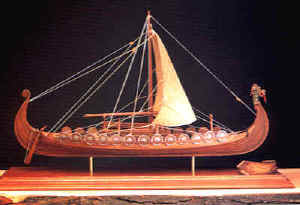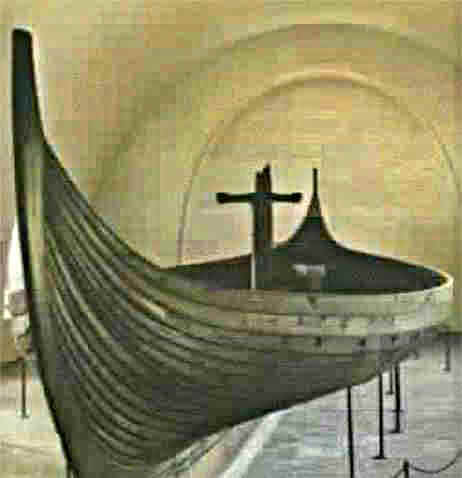|
Reconstruction
of The Gokstad
The following account is the result of an examination of the
ship (1943-44)
To each end of the keel is joined a special piece which forms the
transition to the stem and stern, both by a slightly ascending curve and
by a higher, sharper transverse section. At the ends of the keel the
projecting ridge gives place to a rabbet to which the the ends of each
strake is fastened. The keel, transitional pieces, stem and stern are
connected by scarf joints. That is to say that the two pieces to be
joined are cut at an angle where they overlap, and then they are riveted
with sturdy nails, two rows to each joint and four treenails in the
upper scarf. In this detail the Shipwright also shows great progress
from the techniques known from the ships of earlier clays. In both the
Nydam ship and the Kvalsund boat the connection between the keel and the
stem and stern is made by a flat joint (ends of planks not cut
obliquely) and overlapping horizontally fastened with treenails, no
doubt a less durable method for such an exposed point of the structure.
It was this point that would bear the brunt if the ship were to be
stranded; even in the times of the sagas it is mentioned several times
that the transitional piece might be torn off if the ship struck a
shoal. The stem and stern are each in one piece, and of the finest
materials in the entire ship. Both are unfortunately incomplete now, as
the tops have rotted away. The piece that remains of the stern measures
9' 9" (3 m.) cord length, that of, the stem slightly less. The
greatest width is 17 3/4" (45 cm.) with a sharp profile, narrower
at the the stern, the inner side having a rabbet into which the ends of
the planking are nailed What remains of the Gokstad ship is enough to
show how the stem and stern rise in an elegant elegant curve from the
keel, but it is unfortunately insufficient to tell us anything about
their height or how the tops were made. Only one little thing is
discernible, just at the edge the remaining piece of the stern. Here
there is a moulding that follows the inner side of the stern in a
uniform curve. The curve is interrupted, but begins again after a short
intervening space, now ascending vertically. The lines here show with
certainty that the stern has broadened appreciably toward the top, but
give no indication as to how the top was finished. It is, however,
permissible to point to a closely analogous case, viz. the stern of a
rather large vessel found in the marshes hear Sunnanna, Ryyfylke. The
size of this stern is about two thirds of that of the Gokstad ship, and
thus it gives a fair idea of the vessel to which the stern belonged.
Here too, just as in the Gokstad ship there is a characteristic break in
the transition from a uniform projecting curve to a vertical line. Here
the top is intact, cut into a high point which rises flush with the edge
of the sheer strake. There is a stern of a similar shape on a drawing of
a boat made on the floor-board of the Oseberg ship. Evidently this was
quite a common way of terminating the stern in the Viking Era, but that
is naturally no proof that the Gokstad ship had just this same form. On
the other hand it is evident that the Gokstad ship did not have a dragon
head of the type found on the Oseberg ship, although it may have had a
similar ornament in another form. The dragon-head was usually
detachable, as we know from the saga: Now Olav Trygvason is
afraid, he dare not sail with the head on his ship.
Save cash by shopping at
Overstock.com, as advertised on TV!
Bard is the old name for the ship's prow, and that accounts for the
fame of Erik Jarl's ship Jernbarden (fern=iron) which had
iron pieces fastened to the stein. The word barge is also used
poetically for ships in general.
Joined to the keel, stem and stern is the planking, the skin,
which forms the bottom and sides of the ship. The planking of the
Gokstad ship consists of 16 strakes, each overlapping the one below, and
fastened to it with round-headed rivets driven through both planks from
the outside On the inside the nails are riveted over a little, square
iron plate called a clinch-plate (ro). Only on a small part of the ship,
close to the stem and stern, are the clinch plates on the outside, as
there was not room for using the hammer on the inside. With this
exception, riveting on the outside was considered slovenly and
unsightly. The nails used in the Gokstad ship are about 2/5" (1
cm.) in diameter, and have intervals of about 7/2" (18.5 cm.). All
joints in the planking are made as scarf joints with three nails across,
of which the two on each side are driven through the adjoining strake.
An old rule in those days was that two joints should never be placed
directly one above the other. Should this happen it was considered a
defect, the strip was pieced. This has been carefully avoided in the
Gokstad ship. Another fine point was that the outer end of the
scarf-joint always pointed aft, so as to shed water and ice when the
ship was in motion. A competent man would naturally see to it that all
such rules were observed iii the construction of the ship. While the
planking was being built. The grooves and joints were caulked with
animal hair. Loose, woolly threads, approximately as thick as a finger,
were spun loosely together in a thick cord, presumably with a thin,
hook-shaped twig like those seen used with the boat builders in North
Norway. The caulk was dipped in tar and placed in a groove near the
lower edge of every strake, so that it was pressed lightly together when
the planking was riveted Every seam and joint was carefully caulked, as
were the Joints between the planking, keel, stem and stern.
If you are interested in purchasing a museum quality
model of this 9th century Viking ship visit the Viking Ship Home
page for details. These plans were drawn by members of the University of
Oldsaksamling in Oslo, Norway.
The designated pilot project for Merisol Services, Inc., a nonprofit
public benefit corporation founded in Oregon in February of 1997 was the
construction of a full sized replica of the 76 ' 6" Gokstad Viking
ship.
If you have an interest in service and the philosophy of nonprofits
towards helping others visit our central Web site for information on Merisol
Services, Inc.
|






